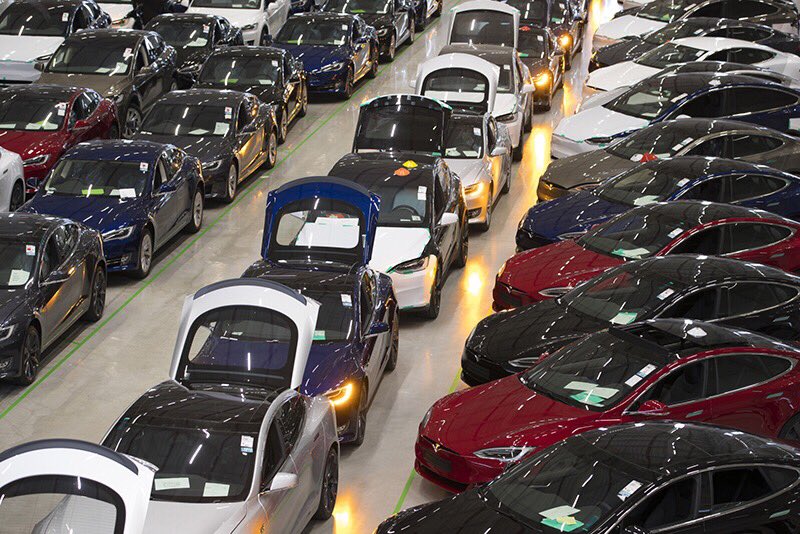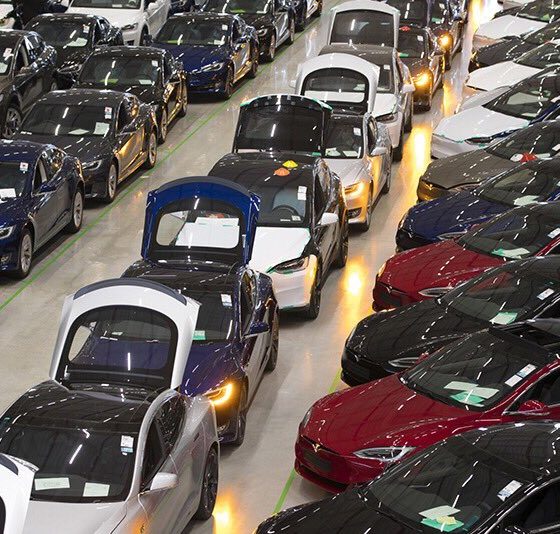

Investor's Corner
Tesla makes its Gigafactory 3 construction timeline even more ambitious
When Tesla announced its estimated timeline for Gigafactory 3, many were skeptical. The electric car maker’s critics dismissed it as another Elon Musk prediction that won’t come true. From Wall Street, Consumer Edge Research senior auto analyst James Albertine flat-out stated that Tesla’s timeline, which estimated the facility’s vehicle production to commence roughly two years after construction begins, is simply “not feasible.”
Tesla is now aiming to accelerate the timeline of Gigafactory 3’s construction even further.
The electric car maker recently released its Q3 2018 vehicle production and deliveries report, revealing that it produced and delivered more than 80,000 electric cars over the past quarter. The company’s Q3 report also mentioned that its Model S and X vehicles saw increased deliveries despite headwinds from the ongoing trade tensions between the United States and China, which add a 40% import tariff on Tesla vehicles entering the country. Tesla notes that overall, it is “operating at a 55% to 60% cost disadvantage compared to the exact same car locally produced in China.” To help address these challenges, Tesla revealed that it is accelerating the construction of Gigafactory 3, which, unlike Gigafactory 1 in Nevada, will be capable of producing electric vehicles.
“We are accelerating construction of our Shanghai factory, which we expect to be a capital efficient and rapid buildout, using many lessons learned from the Model 3 ramp in North America,” Tesla indicated in its Q3 deliveries and production report.
This is something that Tesla teased during its past Q2 2018 earnings call, when CEO Elon Musk and CTO JB Straubel noted that the Shanghai factory would likely be less capital intensive as the company’s facilities in the United States. Musk, for one, noted that Tesla is confident it “can do the Gigafactory in China for a lot less,” adding that the cost of the facility would likely be “closer to $2 billion” at the 250,000 vehicle-per-year rate. Straubel further noted that the company had found several ways to improve efficiency and speed.
“We found a surprising number of ways to improve efficiency and speed and density as well at Gigafactory 1, and all those lessons will absolutely be shared with Gigafactory 3. In just recent weeks and months, we found some – certain areas of production that have been very capital intensive that we’ve been able to speed up with almost no additional CapEx by maybe 20%, even 25% or 30%,” Straubel said.
Tesla did not reveal its updated timeline for Gigafactory 3’s construction, but considering its ambitious initial goal, the new schedule would likely raise even more eyebrows. That said, Tesla’s aim of getting Gigafactory 3 operational within the next couple of years is something that is not as farfetched as the company’s skeptics would assert. The project, after all, has already started moving, with local news site Beijing Business Daily previously noting that around 30% of the facility’s funds are now ready. Reports have also emerged stating that the Shanghai government is assisting Tesla in acquiring loans from local banks to help fund the construction of Gigafactory 3.
Inasmuch as Tesla’s accelerated timeline for Gigafactory 3’s construction is very ambitious, the capability of China to construct large structures quickly could prove to be a strategic advantage for the electric car maker. Chinese construction firms, after all, are responsible for quick, precise feats of engineering, which included projects like setting up a track replacement for a train station in 8.5 hours, and constructing a full-fledged 57-story skyscraper in just 19 days. If Tesla taps into the country’s premier construction workforce, Gigafactory 3 would likely start operations sooner than expected.

Investor's Corner
Tesla stock closes at all-time high on heels of Robotaxi progress

Tesla stock (NASDAQ: TSLA) closed at an all-time high on Tuesday, jumping over 3 percent during the day and finishing at $489.88.
The price beats the previous record close, which was $479.86.
Shares have had a crazy year, dipping more than 40 percent from the start of the year. The stock then started to recover once again around late April, when its price started to climb back up from the low $200 level.
This week, Tesla started to climb toward its highest levels ever, as it was revealed on Sunday that the company was testing driverless Robotaxis in Austin. The spike in value pushed the company’s valuation to $1.63 trillion.
Tesla Robotaxi goes driverless as Musk confirms Safety Monitor removal testing
It is the seventh-most valuable company on the market currently, trailing Nvidia, Apple, Alphabet (Google), Microsoft, Amazon, and Meta.
Shares closed up $14.57 today, up over 3 percent.
The stock has gone through a lot this year, as previously mentioned. Shares tumbled in Q1 due to CEO Elon Musk’s involvement with the Department of Government Efficiency (DOGE), which pulled his attention away from his companies and left a major overhang on their valuations.
However, things started to rebound halfway through the year, and as the government started to phase out the $7,500 tax credit, demand spiked as consumers tried to take advantage of it.
Q3 deliveries were the highest in company history, and Tesla responded to the loss of the tax credit with the launch of the Model 3 and Model Y Standard.
Additionally, analysts have announced high expectations this week for the company on Wall Street as Robotaxi continues to be the focus. With autonomy within Tesla’s sights, things are moving in the direction of Robotaxi being a major catalyst for growth on the Street in the coming year.
Elon Musk
Tesla needs to come through on this one Robotaxi metric, analyst says
“We think the key focus from here will be how fast Tesla can scale driverless operations (including if Tesla’s approach to software/hardware allows it to scale significantly faster than competitors, as the company has argued), and on profitability.”

Tesla needs to come through on this one Robotaxi metric, Mark Delaney of Goldman Sachs says.
Tesla is in the process of rolling out its Robotaxi platform to areas outside of Austin and the California Bay Area. It has plans to launch in five additional cities, including Houston, Dallas, Miami, Las Vegas, and Phoenix.
However, the company’s expansion is not what the focus needs to be, according to Delaney. It’s the speed of deployment.
The analyst said:
“We think the key focus from here will be how fast Tesla can scale driverless operations (including if Tesla’s approach to software/hardware allows it to scale significantly faster than competitors, as the company has argued), and on profitability.”
Profitability will come as the Robotaxi fleet expands. Making that money will be dependent on when Tesla can initiate rides in more areas, giving more customers access to the program.
There are some additional things that the company needs to make happen ahead of the major Robotaxi expansion, one of those things is launching driverless rides in Austin, the first city in which it launched the program.
This week, Tesla started testing driverless Robotaxi rides in Austin, as two different Model Y units were spotted with no occupants, a huge step in the company’s plans for the ride-sharing platform.
Tesla Robotaxi goes driverless as Musk confirms Safety Monitor removal testing
CEO Elon Musk has been hoping to remove Safety Monitors from Robotaxis in Austin for several months, first mentioning the plan to have them out by the end of 2025 in September. He confirmed on Sunday that Tesla had officially removed vehicle occupants and started testing truly unsupervised rides.
Although Safety Monitors in Austin have been sitting in the passenger’s seat, they have still had the ability to override things in case of an emergency. After all, the ultimate goal was safety and avoiding any accidents or injuries.
Goldman Sachs reiterated its ‘Neutral’ rating and its $400 price target. Delaney said, “Tesla is making progress with its autonomous technology,” and recent developments make it evident that this is true.
Investor's Corner
Tesla gets bold Robotaxi prediction from Wall Street firm
Last week, Andrew Percoco took over Tesla analysis for Morgan Stanley from Adam Jonas, who covered the stock for years. Percoco seems to be less optimistic and bullish on Tesla shares, while still being fair and balanced in his analysis.

Tesla (NASDAQ: TSLA) received a bold Robotaxi prediction from Morgan Stanley, which anticipates a dramatic increase in the size of the company’s autonomous ride-hailing suite in the coming years.
Last week, Andrew Percoco took over Tesla analysis for Morgan Stanley from Adam Jonas, who covered the stock for years. Percoco seems to be less optimistic and bullish on Tesla shares, while still being fair and balanced in his analysis.
Percoco dug into the Robotaxi fleet and its expansion in the coming years in his latest note, released on Tuesday. The firm expects Tesla to increase the Robotaxi fleet size to 1,000 vehicles in 2026. However, that’s small-scale compared to what they expect from Tesla in a decade.
Tesla expands Robotaxi app access once again, this time on a global scale
By 2035, Morgan Stanley believes there will be one million Robotaxis on the road across multiple cities, a major jump and a considerable fleet size. We assume this means the fleet of vehicles Tesla will operate internally, and not including passenger-owned vehicles that could be added through software updates.
He also listed three specific catalysts that investors should pay attention to, as these will represent the company being on track to achieve its Robotaxi dreams:
- Opening Robotaxi to the public without a Safety Monitor. Timing is unclear, but it appears that Tesla is getting closer by the day.
- Improvement in safety metrics without the Safety Monitor. Tesla’s ability to improve its safety metrics as it scales miles driven without the Safety Monitor is imperative as it looks to scale in new states and cities in 2026.
- Cybercab start of production, targeted for April 2026. Tesla’s Cybercab is a purpose-built vehicle (no steering wheel or pedals, only two seats) that is expected to be produced through its state-of-the-art unboxed manufacturing process, offering further cost reductions and thus accelerating adoption over time.
Robotaxi stands to be one of Tesla’s most significant revenue contributors, especially as the company plans to continue expanding its ride-hailing service across the world in the coming years.
Its current deployment strategy is controlled and conservative to avoid any drastic and potentially program-ruining incidents.
So far, the program, which is active in Austin and the California Bay Area, has been widely successful.








